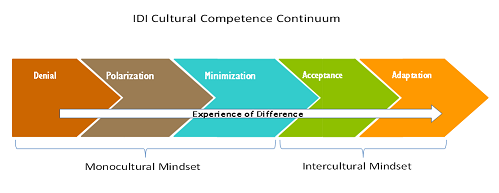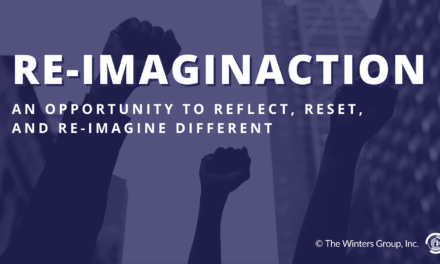
I want to share with you a recent challenge I’ve encountered recently in my work that I think is also an obstacle to diversity and inclusion work in general. And then I hope to offer an analogy that I think is helpful as we work towards a solution. So first,
The Challenge:
I have been busy lately working with the Intercultural Development Inventory® (IDI®). If you are unfamiliar with the IDI®, it is a quantitative based tool for measuring ones intercultural competence. Individuals take the assessment, which places them along a continuum that measures their particular orientation to cultural commonality and difference. An integral part of the assessment tool is a debriefing session with a qualified administrator (QA) to explain the results and the developmental “next steps” for growth.
It is in these debriefing sessions that I have noticed an interesting trend. Most people who take the assessment are very eager to more fully understand their scores, the nature of the tool, and their prescribed plan for growth. But every now and then there are participants who take a very defensive, and sometimes aggressive, stance towards the assessment tool and their particular results. This is usually in the form of questioning the tools validity or rejecting its relevance to their lived behavior and perspectives.
As a QA of the tool, it is my job to offer resources from the scientific community at large that argue for the tool’s reliability and usefulness. But this is rarely the kind of answer that these particular individuals are looking for. In fact, I think the defensive nature of most objections to the tool come from a different place: namely, the competitive nature of our culture.
The IDI® has now been taken by over 500,000 people across nearly every dimension of diversity you could think of. But my guess is that a defensive rejection of the tools validity is probably a largely Western response. In America especially, we are groomed to think in terms of black and white, right and wrong, and winners and losers. In addition, the standardized nature of our education system furthers the idea that tests are about passing and failing. No middle ground. This creates situations where some individuals feel demeaned, defeated, or singled out by what they interpret as “failing” the test.
The Solution:
I think the educator in me has made debriefing sessions with “defensive” and “defeated” individuals particularly troubling and so I have been thinking a lot lately about where this disconnect is coming from and ways to address it. In my sessions with individuals I try to emphasize that the continuum in the tool is fluid and that growth in cultural competence is a process. Sometimes this helps. Other times, the stigma of “winning and losing” and “passing and failing” is too deeply embedded to overcome. An analogy comes to mind however that I think may be helpful in helping people make this paradigm shift.
I spent two summers in college as a white water rafting guide in the mountains of North Carolina. Although there are a small number of people who raft competitively for sport, the majority of our customers came to the river to enjoy the beauty of the mountains, the thrill of the river’s rapids, the challenge of overcoming its obstacles, and with the company of their friends and family. I cannot remember a single time in my two years as a guide someone speaking of rafting trips in terms of winning and losing. Yes, there was a starting point and ending point. But there was no real “right” or “wrong” way to get there. Granted, falling out of the raft was not always enjoyable, but even this “worst case scenario” was usually talked about after with light hearted reminiscing about the experience.
The culture of rafting is about the experience and adventure of the river and navigating its rapids. If you’ve ever rafted, you know that guides always prepare their groups beforehand for the particular river’s rapids; their varying level of difficulty (rated on a scale of 1-5), unique characteristics, and techniques to successfully overcome their challenges. A river’s level of difficulty and the unique nature of their rapids is what make them challenging, fun, and popular among enthusiasts. In the same way, growth in cultural competence is like navigating a river.
The IDI® continuum has 5 cultural orientations (or rapids) that describe how one navigates cultural differences and similarities. They are: denial, polarization, minimization, acceptance, and adaptation. Like a river’s rapids, they each have defining characteristics that make them unique in determining their level of “difficulty” for dealing with cultural difference. And since growth in cultural competence is a process, it is like navigating a river in that each of us must pass through the same rapids (or orientations) at some point in our journey.

When I think about the countless hours I spent reminiscing about various trips down the river with friends it was always in objective terms that described our experiences in overcoming the obstacles of the river. The river was revered as something much larger than ourselves, which gave each adventure a universal quality that made talking about it a communal activity. There were no winners or losers. Everyone traversed the same river, the same rapids, and experienced the same inevitable challenges that came with them.
The experience of feeling defeated or victorious is not unique to the IDI®. It is a result of diversity and inclusion work more broadly which sees inclusion and cultural competency as a zero sum game. Like a river, there are only the places where we start, the expected challenges in between, and the realization that growth is continual. I look forward to the day when we all see that we are up against a river bigger than ourselves; it has rapids that we all must go through and that there are no winners and losers.


















